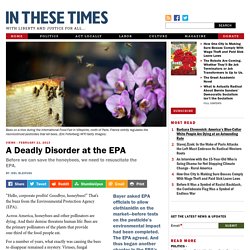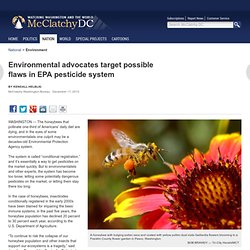

A Deadly Disorder at the EPA. Before we can save the honeybees, we need to resuscitate the EPA.

Bayer asked EPA officials to allow clothianidin on the market—before tests on the pesticide’s environmental impact had been completed. The EPA agreed. And thus began another chapter in the EPA’s sad history of protecting not the environment, but corporate interests. “Hello, corporate profits! Goodbye, honeybees!” Across America, honeybees and other pollinators are dying. For a number of years, what exactly was causing the bees to disappear remained a mystery.
Now scientists have zeroed in on one culprit. Neonics, which are chemically related to nicotine, are fast becoming the most widely used insecticides in the world. Clothianidin and imidacloprid are the two most commonly used neonicotinoids in the United States. Imidacloprid was first introduced in 1994, as an alternative to organophosphate pesticides, such as diazinon and malathion. Pesticide plague. Flawed record-keeping - Environment. Environmental advocates target possible failings in pesticide registration system.

THE honeybees that pollinate one-third of Americans’ daily diet are dying, and in the eyes of some environmentalists, one culprit may be a decades-old Environmental Protection Agency (EPA) system. US Environmental Protection Agency. WP: EPA’s system of tracking pesticides harmful to honeybees, critics say. Insecticides conditionally registered in the early 2000s have been blamed for impairing honeybees’ immune systems; in the past five years, the honeybee population has declined 20 to 30 percent each year, according to the U.S.

Department of Agriculture. “To continue to risk the collapse of our honeybee population and other insects that support our ecosystems is a tragedy,” said Jonathan Evans of the Center for Biological Diversity, a national environmental advocacy group. The criticism of the EPA’s conditional registration system is nothing new. A Government Accountability Office report from August, for example, said the agency has a confusing record-keeping system for tracking pesticides — a problem the GAO first flagged in 1986.
The recent report helped revive claims that conditional registration is unsafe. For its part, the EPA said its 2012 review showed that record-keeping troubles have not affected the safety of products it has approved. Environmental advocates target possible flaws in EPA pesticide system. WASHINGTON — The honeybees that pollinate one-third of Americans’ daily diet are dying, and in the eyes of some environmentalists one culprit may be a decades-old Environmental Protection Agency system.

The system is called “conditional registration,” and it’s essentially a way to get pesticides on the market quickly. But to environmentalists and other experts, the system has become too loose, letting some potentially dangerous pesticides on the market, or letting them stay there too long. In the case of honeybees, insecticides conditionally registered in the early 2000s have been blamed for impairing the bees’ immune systems; in the past five years, the honeybee population has declined 20 percent to 30 percent each year, according to the U.S. Department of Agriculture. “To continue to risk the collapse of our honeybee population and other insects that support our ecosystems is a tragedy,” said Jonathan Evans of the Center for Biological Diversity, a national environmental advocacy group. Pesticides: EPA Should Take Steps to Improve Its Oversight of Conditional Registrations. What GAO Found The total number of conditional registrations granted is unclear, as the Environmental Protection Agency (EPA) reports that its data are inaccurate for several reasons.

First, the database used to track conditional registrations does not allow officials to change a pesticide's registration status from conditional to unconditional once the registrant has satisfied all requirements, thereby overstating the number of conditional registrations. Second, EPA staff have misused the term "conditional registration," incorrectly classifying pesticide registrations as conditional when, for example, they require a label change, which is not a basis in statute for a conditional registration. According to EPA documents and officials, weaknesses in guidance and training, management oversight, and data management contributed to these misclassification problems.
The extent to which EPA ensures that companies submit additional required data and EPA reviews these data is unknown. How a 40 Year-Old EPA Loophole Helped Kill the Bees. Scientists have issued dire warning after dire warning: honey bees all over the world are dying at an unprecedented rate, and without them, our agricultural system could be the next to go.

Bees pollinate one-third of Americans’ daily diet. If they go extinct, we’d lose more than honey; the size of your average produce section would shrink dramatically. Then there are all the plants pollinated by bees that we don’t eat. Those are kind of important, too. Colony Collapse Disorder has been troubling bee keepers and farmers for many years, and though the consequences threaten every single human on the planet, the United States has been painfully slow to act. But these chemicals don’t just sell and spray themselves. “…it’s essentially a way to get pesticides on the market quickly,” writes Kendall Helblig for McClatchy DC. The article goes on to point out that even after these products are “conditionally approved” the EPA struggles to keep track of them or their impacts.